- This article has a collection of images to further represent its content. To see its gallery, visit Kaworu Nagisa/Gallery.
| “ | The fate of man... The hope of man is written in sorrow. | ” |
| —Kaworu Nagisa |
Kaworu Nagisa (渚 カヲル, Nagisa Kaworu?), also known as Tabris, is a fictional character from the Neon Genesis Evangelion franchise. He is the Fifth Child and the seventeenth Angel.
Sent to NERV by SEELE as a replacement pilot for Unit-02 after Asuka's synchronization ratio falls below usability, he breaks into Terminal Dogma in order to return to Adam, but after he discovers the being there is actually Lilith, he allows Shinji to destroy him.
He appears in The End of Evangelion during Third Impact, communicating with Shinji in regard to the choice of whether to accept or reject Instrumentality.
Story
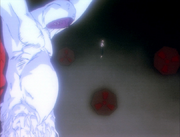
Kaworu stands before Lilith.
Kaworu is first seen in episode 24, sitting on a stone amongst wreckage due to the previous battle with Armisael, the Sixteenth Angel. Shinji is present, confused and frustrated about what to do since all of his friends have evacuated the city, Asuka is mentally distressed and in a ward, and Rei appears to not remember recent events. Kaworu abruptly tells Shinji that music is beautiful after he stops humming, and begins conversing with him in a kind manner, referring to him as "Mr. Ikari". After Shinji asks him how he knows who he is, Kaworu tells Shinji he is "rather ignorant of (his) own position".[1]
Following their initial meeting, Kaworu accompanies Shinji to a NERV bathing room. While sitting together in the bath, the boys display a degree of comfort around one another. At one point, Kaworu places his hand on Shinji's, who allows Kaworu's hand to linger on his own, Kaworu then proclaims he loves Shinji. At the end of the bath house scene, Shinji tells Kaworu that he needs to go to bed, to which Kaworu is confused and asks if they will go together, to which Shinji is quick to decline the offer, though he does spend the night at Kaworu's apartment, sleeping on the floor beside Kaworu's bed.[2]
After the NERV staff become suspicious of Kaworu's high synchronisation rates with Unit-02, and Misato and Hyuga learn that he can set his synch rate to anything he wants, an alert is issued that Unit-02 has activated without a pilot inside, and someone is descending towards Terminal Dogma; it is Kaworu, who is identified as the 17th and final Angel. Shinji is placed into Unit-01 and pursues Kaworu, who manipulates Unit-02 to slow down Shinji in Unit-01.
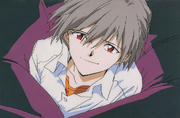
Kaworu asks for Shinji to kill him.
Kaworu proceeds to Terminal Dogma, and after activating the door to open and entering, appears to reach an understanding that the giant crucified there is in fact not Adam, but rather Lilith. After Shinji defeats Unit-02, Kaworu allows Shinji to grasp him in Unit-01's hand. Shinji is hurt that Kaworu betrayed him just like (his) father did and lied to him about his identity after befriending him. However, Kaworu tells Shinji that his life is complete and had more meaning after meeting him, and requested to be killed, claiming that the only freedom there is it's to choose how one dies. Following a period of silence, Shinji grants his request.
In The End of Evangelion, the Mass Production Evangelion's Dummy Plugs are prominently marked "KAWORU", suggesting that SEELE was in possession of clones of Kaworu just as NERV was in possession of clones of Rei for the Dummy Plug system for the original Evas.
Kaworu first appears in The End of Evangelion as the Human Instrumentality Project is being initiated. At first, when the giant Lilith/Rei appears to Shinji, he is terrified by it. It then transforms into Kaworu, a form which Shinji accepts. Kaworu reappears when Gendo is confronted by Yui while Instrumentality takes place, accusing Gendo of running away from the world before getting hurt, before Gendo is killed by an apparition of Unit-01.
Kaworu, along with Rei, appears in Shinji's mind and argues with Shinji in regards to the case of humanity and in favor of individualism and free choice (specifically, in favor of Shinji rejecting Instrumentality).
Profile
Kaworu[3] (渚カヲル) is both the 17th Angel and the Fifth Child. Although classified as an Angel, Kaworu is similar to Rei Ayanami in being a Seed of Life that inhabits a human body. Despite his human form, Kaworu does not consider himself to be human, since he refers to humans as "the Lilin".
Kaworu appears humming the fourth movement of Beethoven's Ninth Symphony, the same music that plays during his descent into Terminal Dogma and so serves as a leitmotif for his character. The Ninth Symphony itself incorporates an adaptation Friedrich Schiller's Ode to Joy (Ode an die Freude), a poem dedicated to the unity of all men under God. The moment Kaworu opens the doors to Terminal Dogma is in synch with the line "Und der Cherub steht vor Gott"- "And the Cherub (Angel) stands before God".
Kaworu's body appears to have been created as a result of the Contact Experiment with Adam, wherein DNA from an unknown human donor dove into and fused with Adam's flesh,[4] explaining Hyuga's discovery that Kaworu was "born" on the day of Second Impact.[5] SEELE salvaged Adam's disembodied soul into Kaworu,[6][7] whom they may have recovered in embryonic form in Antarctica.[8]
Kaworu's origin from Adam, only intimated in the anime, is flatly stated in Sadamoto's manga.[9]
Since Kaworu was delivered to NERV by SEELE, it is believed that Kaworu has been living under SEELE's surveillance prior to his appearance in the series.
Kaworu is brought to NERV as the Fifth Children to replace Asuka,[10] who is no longer able to pilot Unit-02. He is only able to pilot Unit-02 whilst its soul is in hiding. In his first test, Kaworu immediately achieves impressive synchronization results. It later emerges that Kaworu is able to achieve whatever level of synchronization he chooses with Unit-02.
Though he seems to have been sent to destroy it, Kaworu shows a marked interest in human culture, as well as human issues of pain and loneliness.
When Shinji first sees him sitting on top of an angel statue (a visual theme that binds together appearances of Kaworu[11]), Kaworu was humming part of the composer Beethoven’s Ninth Symphony, the fourth and final movement "Presto - Allegro assai", more popularly called the "Ode to Joy" after the poem by Friedrich Schiller, from which it is adapted. He then says that he considers singing to be the finest achievement of the Lilin (human) civilization.
Kaworu appears comfortable in his identity (far more than Rei), and also warmer and more emotionally open. However he does show a detachment from human protocols and shares Rei's tendency to speak in universal rather than personal terms.
As the vessel for Adam's soul, Kaworu's designation is "Tabris" (Arabic: تبريس). As revealed in Newtype publications such as ADAM and used by Keel Lorenz in the Manga. Tabris (タブリス), the 17th and final Angel. He is considered the Angel of free will, which is considered a gift of God; Although Kaworu was sent by SEELE for a specific purpose, he also has his own agenda.
Unlike the Angels who came before him, but like Rei, Kaworu has a Lilin body, with no visible physical difference from a regular human except for very pale skin, light grey hair and red irises. Although his body is presumably composed of the same "particle-wave matter" as Rei and the Angels, it is impossible to say if he possesses a core and S² Engine. Tabris is the only Angel to infiltrate Terminal Dogma.
Kaworu's human body is a vessel for the salvaged soul of Adam itself, and wields all of the power that comes with it. He is in effect Adam reborn as a human. His A.T. Field is described by the Magi as the strongest yet encountered (until it is surpassed by Rei's). Kaworu is observed using it for levitation, to control Unit-02, as a massive barrier that prevents the Command Center from receiving wave transmissions, and, (evidently) to bypass the LCL Plant's locking mechanism.
By being both the First Angel (Adam, whose body and soul were separated in Second Impact) and the Seventeenth and final Angel, he is in effect both the first and the last of his kind. Kaworu is "born from Adam", and describes Adam as being the "Mother of us all". As Kaworu is the vessel for Adam's soul, that paradoxically makes him his own mother.
Relationships
Relationship with Shinji
Little is known of Kaworu's motivations for representing an idealized friend to Shinji Ikari. His interest in Shinji might have stemmed from his interest in human nature in general, Shinji representing a prime example of human pain and loneliness. Apart from very quickly understanding Shinji's personality, he understood Shinji as Shinji had been wanting someone to do for a long time and was interested in Shinji's welfare without asking anything in return. He does seem to consider meeting Shinji as extremely significant after listening to what Shinji has to say about himself and his relation to his father during his overnight stay in Kaworu's room. Kaworu's proclamation of love proved he did care for Shinji, and was also presented when he allowed Shinji to kill him so humanity could survive. Later, Shinji confesses to have also loved Kaworu, indicating how the feeling was mutual, and their relationship leading to be potentially romantic.
Relationship with SEELE
Kaworu was sent to NERV by SEELE in order to advance their goal of Instrumentality through a Third Impact that would occur under their direction. Before his final battle, Kaworu is seen talking with a phantasm of SEELE that apparently only he can see and it can be assumed that he has been in previous communication with SEELE (for example being briefed on his mission to enter NERV as a pilot). The conversation indicates that they have (falsely) told them that they favor the "true successor" Angels over their own kind.[12]
It is uncertain what exactly SEELE had in mind for Kaworu. Did they plan for him to attack Terminal Dogma, or was that his own plan? We do know that once the attack commenced they wanted Unit-01 to defeat him.[13] Was this their plan all along, or was it because his foray into the bowels of NERV was a betrayal?
This section of the article is a stub. You can help the Neon Genesis Evangelion Wiki by expanding it.
Other media
Rebuild of Evangelion
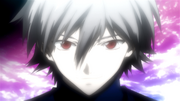
Kaworu in Rebuild
Kaworu appears in Evangelion 1.0, rising from a coffin on the moon in sight of an Eva-sized giant in a white covering (Evangelion Mark.06 under construction). He speaks to Keel Lorenz (via his monolith), agreeing that "the child" is progressing as predicted in the Dead Sea Scrolls, and saying that "The Third is still the same." He ends the conversation saying that he hopes to meet Shinji Ikari. Bizarrely, Kaworu appears to be capable of breathing and even speaking in the absence of air.
In Evangelion 2.0, Kaworu is seen on the moon base (Tabgha base), when Fuyutsuki and Gendo approach it on an SSTO to inspect the construction of the new, SEELE-built Unit-06. Fuyutsuki, looking out of the spacecraft window, observes Kaworu sitting on Unit-06's finger, clad only in his trousers, and wonders whether Kaworu is human or not. Kaworu greets Gendo as "Father",[14] although the circumstances render it impossible to determine whether he used the word in a literal or metaphorical sense. Kaworu is seen putting on a plugsuit immediately before the battle with Zeruel, standing on top of the now-complete Unit-06, confirming that he is the new Evangelion's pilot. He reappears at the end of the movie and stops Unit-01 from transforming with a staff-like weapon thrown from his Eva, addressing Shinji and saying "This time, only you will find happiness".
The preview of the third film shows Kaworu confronting the other pilots in an unknown location. It should be noted that in his appearance while piloting Mark 06 at the end of "You Can (Not) Advance" when referring to Shinji about bringing him "happiness" his expression is defiant instead of the usual bright smile face.
In Evangelion 3.0: You Can (Not) Redo, Kaworu has a role similar to the one of the original series, wherein he gains the trust of Shinji. His actions (playing the piano in duet) allow the latter to sync with him, unconsciously preparing the two pilots for the piloting of Evangelion 13. Wanting to fulfill the wish of Shinji to cancel the Third Impact, he is behind the plan to recover the Spear of Longinus and Spear of Cassius, realizing during Shinji's fight against Asuka finally that he was deceived. He begged Shinji not to pull the two Longinus spears only for his own controls to shut off, leaving him incapable of stopping Shinji. After Evangelion 13 devours and kills the Twelfth Angel he is cast down from the 1st Angel to the 13th. He then decides to stop the Fourth Impact by piercing the core of Evangelion 13 with the two spears before being killed by the DSS Choker. His image can be seen after the ejection of the entry plug.
Manga
In this manga series, Kaworu is portrayed as being ignorant of human emotions and taboos regarding social interaction and personal space, creating some comic relief. Also, some events concerning him are changed, and he appears earlier as well. He appears briefly at the end of vol. 7 in the presence of SEELE. In his appearance in book 9 (when Shinji first meets him), Shinji finds him playing a piano in the ruins of a church. He asks Shinji if he knows the name of the song, to which Shinji replies "the Ode to Joy." (In the anime, he was sitting on a rock by the sea, humming the tune of the same song.)
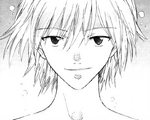
Kaworu in the manga
Another important difference in this manga is that Shinji initially does not like or trust Kaworu. Just after their first meeting, Kaworu calmly kills an abandoned kitten that had been following Shinji; his pragmatic reply to Shinji's question of "why" (it was kinder to kill the kitten rather than let it eventually starve to death) made Shinji feel that Kaworu was like Rei when Shinji first met her. Later, after seeing Shinji and Kaworu arguing, Kensuke thinks to himself, "Creepy...something inhuman..." After Shinji brings Kaworu to NERV, he tells Asuka that she needs to open her heart to her Eva in order to operate it; this line was delivered by Rei in the anime. In the aftermath of the battle with Arael, SEELE interrogates Kaworu, and he mentions that he finds human emotions and attachments fascinating.
In volumes 9 and 10, Kaworu pilots Unit-02 alongside Rei in the battle with the Angel Armisael. The Angel partially assimilates Unit-02, connecting the already-assimilated Rei to Kaworu and causing him to feel Rei's love for Shinji, which makes him cry. After the battle, Shinji nearly punches Kaworu after he calls Rei a fool. Despite this, Shinji stays in Kaworu's apartment rather than go home to Misato, believing that being around the emotionally distant Kaworu would be more tolerable than being around people who would also be sad about Rei's death. He reluctantly accepts Kaworu's offer to share his bed. That night, Shinji begins to hyperventilate while having a nightmare, and Kaworu uses the chance to kiss Shinji, using lack of a handy paper bag as an excuse. Shinji becomes angered and repulsed when he wakes fully and realizes what Kaworu did, and is even more angered when Kaworu asks him if what he felt while connected to Rei was love and attempts to physically advance on Shinji. Later, after Rei re-appears, Shinji returns to Misato's apartment with the barest of good-byes, visibly upsetting Kaworu. Volume 11 plays out the same way as episode 24. However, Shinji is confused about his feelings towards Kaworu, as the latter persuades the former to kill him as "proof of what (Shinji) really think(s) of (him)" instead of obsessing over his own guilt in the aftermath.
In the following chapter (75), Shinji admits that he was attracted to Kaworu, even though he knew he shouldn't be. With his confused feelings at everyone else he was close with abandoning him, and Kaworu being the only person showing the slightest bit of affection to him at the time, Shinji regrets killing the only person who has ever genuinely cared about him with no strings attached.
The bonus materials in volume nine of the English adaptation of the manga contain an article written by the editor Carl Gustav Horn which compares Kaworu to the character Satan in Mark Twain's novella, The Mysterious Stranger.[15]
Neon Genesis Evangelion Addition soundtrack
A scene in the parodical audio drama titled "After the End" (Shuukyoku no Tsudzuki), released on the official Neon Genesis Evangelion Addition soundtrack, features all of the original Japanese voice actors who return to voice their characters and break the fourth wall, talking about how they need to produce a 27th episode and increase the appeal of the series as well as playing comically exaggerated versions of themselves as actors playing the characters of the series, and at other times, playing the actual characters themselves. When Kaworu appears, (loosely translated) Asuka exclaims "oh great, it's that homosexual guy", to which Kaworu replies "I really wish you wouldn't make statements like that, when you lack any evidence for them", reflecting the debate about the character.
Shinji Ikari Raising Project
In the noncanonical Shinji Ikari Raising Project, Kaworu is an agent sent by SEELE to infiltrate Shinji's school (much like the original). Here, he is helped by Ritsuko Akagi. He teases Shinji frequently, drawing Asuka's (and eventually, Rei's) ire. He is also implied to be the cause of a blackout at NERV (in an homage to the original outage in the anime), and is also a potential romantic interest for Shinji.
Neon Genesis Evangelion: Gakuen Datenroku
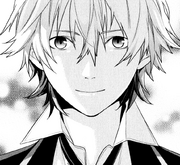
Kaworu in Gakuen Datenroku
In this spin-off, Kaworu is a transfer student who takes an interest in Shinji, who is suspicious of his relationship with Rei. With Rei, Kaworu secretly fights against Angels and has the ability to generate an AT Field to defend against attackers and his Eva manifests as a sword. He uses the name Tabris to play online games. He, as revealed in chapter eight, is an "artificially created child" and has spent all of his life until now in facilities. He is ignorant of many social customs, and considers himself to be close friends with Shinji. Later, however, Kaworu confides to Shinji that he is really the 17th Angel, Tabris. In the final volume, Kaworu sacrifices himself in order to save Shinji, taking Yui Ikari's place in the Tree of Y'ggdrasil. Before disappearing, he confides in Shinji that it was become of him that he rejected the destructive nature of the Angels and chose to embrace humanity.
Super Robot Wars
Kaworu appears in the Super Robot Wars games in the same role he had in Evangelion. However his spirit appears in Super Robot Wars Alpha 3. In the game's adaption of The End of Evangelion, Kaworu's spirit returns to take control of Unit-00 and aid Shinji in battle and help rescue Rei from inside Lilith. He also visits Neki Basara and voices his approval of his music. He makes his final appearance during the final battle with Kaiser Ephes where he encourages the Eva pilots not give up.
Edge Of Spider-Verse
Kaworu makes a cameo appearance alongside Asuka, Rei and Shinji in the fifth chapter of Marvel's Edge of Spider-Verse storyline.
Notes and references
In early designs, Kaworu was depicted as a school boy with a pet cat who could switch to an "Angel form".[16] In vol. 9 of the manga, one of Sadamoto's artworks is a portrayal of Kaworu dressed in black and holding a black cat.[15]
Kaworu was named by screenplay writer Akio Satsukawa.[17] Kaworu's surname "Nagisa" comes from the Japanese word nagisa (渚), meaning "waterside" or "shore", concerned with sea. It also comes from Japanese movie director Nagisa Oshima.[17] Adding to these, the character "渚", when divided, can be read as "shi-sha" (シ者). The title of episode 24 is "The Last Shisha" (最後のシ者, Saigo no Shisha?). "シ者" includes two Japanese words read as "shisha" (the character "シ" only represents the sound "shi"). The first is "messenger" or "apostle" (使者, shisha?), while the other is "dead (person)" (死者?).[17]
Gainax renders his name in Romaji as "Kaworu," not "Kaoru" as would be given by most romanization schemes. The reasons for the difference in the naming have not been explicitly detailed by the series' creators; one theory is that the name is based on the original kana of the name Kaoru Genji, from The Tale of Genji.[17]
As a promotion for its 10th Anniversary Special Edition of Evangelion, ADV Films published a humorous bumper sticker which reads "KAWORU DIED FOR YOUR SINS" (カヲルはあなたの罪のために死んだ, Kaoru wa anata no tsumi no tame ni shinda?)).[18] Mania Entertainment's Chris Beveridge described Kaworu's death in the anime as an "extremely powerful moment" due to the fact that after a minute without dialogue, his head's shadow appears touching the water.[19]
Kaworu Nagisa was the second most popular male character in the 1997 Animage poll.[20] In a Newtype poll from March 2010, Kaworu was voted as the second most popular male anime character from the 1990s.
The possibly homosexual undertones of Kaworu's interactions with Shinji has been a persistent topic of debate among fans of Evangelion since the series' first run as discused in the Patrick Drazen's book Anime Explosion! The What? Why? & Wow! Of Japanese Animation.[21] Patrick Drazen's self-admittedly minority view is that Kaworu's offer of love for Shinji is a tactic that Kaworu as the last Angel used to disarm Shinji.[22] Gainax is clearly aware that the audience associates Kaworu with bishounen tropes, and have produced artworks such as splash pages for their website in reference to Kaworu's ambiguity and the audience's reaction to the character.[22]
- ↑ A phrase that Ryoji Kaji said to Shinji when they first met
- ↑ Episode 24
- ↑ The name "Nagisa" is a pun. The Kanji character "Nagisa" consists of the Katakana "shi" and the Kanji "sha", forming the word "Shisha", or "messenger". Kaworu, after all, is the final messenger, and the word used for "Angel" in the original Japanese dub is "Shito", or "Apostle" (messenger of God). See Character Name Origins for more information.
- ↑ Neon Genesis Evangelion. Episode 21'.
Man E: "The contact experiment with the donor is scheduled for the 13th of next month. There will be time for any adjustments."
(later) Woman B: "The genes that dived into Adam have already undergone physical fusion!" - ↑ Neon Genesis Evangelion. Episode 24. Platinum subtitles.
HYUGA: But the one thing we do know [about Kaworu Nagisa] is that his birthday coincides with the Second Impact." - ↑ Neon Genesis Evangelion. Episode 24'. Platinum subtitles.
SEELE A (speaking to Kaworu): [Adam's] salvaged soul exists only within you. - ↑ Neon Genesis Evangelion 2. Classified Information: Adam. "At the time of Second Impact, [Adam's] body was torn apart, and its soul flew off somewhere as a result. Adam's soul was later recovered by SEELE and incarnated."
- ↑ End of Evangelion Theatrical Booklet. Glossary: Kaworu Nagisa. "It is likely that he was an Angel which had been captured by SEELE in the embryo stage." (Translation by bochan_bird.)
- ↑ Neon Genesis Evangelion (manga). Volume 11, Stage 72.
- Ritsuko: Kaworu Nagisa... His date of birth is the same as Second Impact. Probably because, on that day, in that place, he was the final Angel to be born.
- Misato: You can’t mean... Are you saying that all the Angels were born from Adam? What did humans do to Adam on that day?
- Ritsuko: Humans tried to return Adam to an egg before the other Angels awoke. The result was Second Impact. Among the data from your father’s research team that was retrieved just before it happened, I have heard that there were indications of an attempt to use human genes in some way. If that was actually done in secret, if the Angel born at that time took human form, and if the Committee got their hands on it, then according to MAGI everything adds up.
- ↑ Kaworu's Plug Suit has an inverted, divided triangle symbol on its chest rather than a proper number, though he was sent to be the replacement pilot for Unit-02.
- ↑ See Reichu's analysis (archive) of all the visual allusions and connections to the angel statute.
- ↑ One section of this conversation concerns the "Lilins' hope" The word hope, "kibou" appears several times, once, when used by Kaworu, in katakana instead of kanji:
"SEELE 04: "There is a man trying to close the box before the hope at the bottom appears."
Kaworu: "Hope? You're saying that is the Lilin's hope?"
SEELE ??: "Hope exists in as many forms as there are people."
SEELE ??: "And that is because hope only exists in the hearts of people."
Keel: "However, our hope is becoming substantiated."
It is likely that it is spelled this way just for emphasis, but it has been suggested that there is some wordplay going on here; spelled with a different kanji, kibou means "trick". This might be a subtle clue that Kaworu is being deceived. - ↑ SEELE 02: "Humans forget their foolishness and repeat their mistakes."
SEELE ??: "If humans do not redeem themselves willingly, they will not change."
SEELE ??: "We will not rely on the powers of Adam or the Angels."
KEEL: "Our only choice is to make changes with our own hands for the future. I will be praying that Unit-01 will accomplish its task." - ↑ Evageeks.org: Kaworu calling Gendo "father". Retrieved 2011/02/19.
- ↑ 15.0 15.1 ISBN 1-59116-707-8
- ↑ NEWTYPE 100% COLLECTION: NEON GENESIS EVANGELION. 1997 Kadokawashoten. ISBN 4-04-852700-2. Partial translation.
- ↑ 17.0 17.1 17.2 17.3 Evangelion character names; Translation of essay by Hideaki Anno about character name origins; includes a link to the original essay in Japanese.
- ↑ EVA 10th Limited Edition
- ↑ Neon Genesis Evangelion Collection 0:8 from Mania Entertainment.
- ↑ 第19回アニメグランプリ [1997年6月号] from Animage.jp.
- ↑ Drazen, Patrick (October 2002). '"A Very Pure Thing": Gay and Pseudo-Gay Themes' in Anime Explosion! The What, Why & Wow of Japanese Animation Berkeley, California: Stone Bridge Press p.95 ISBN 1-880656-72-8.
- ↑ 22.0 22.1 Drazen, Patrick (October 2002). "Evangelion" in Anime Explosion! The What, Why & Wow of Japanese Animation Berkeley, California: Stone Bridge Press p.308 ISBN 1-880656-72-8.
| Seeds of Life & Angels | ||
|---|---|---|
| Neon Genesis Evangelion | Adam • Lilith • Sachiel • Shamshel • Ramiel • Gaghiel • Israfel • Sandalphon • Matarael • Sahaquiel • Ireul • Leliel • Bardiel • Zeruel • Arael • Armisael • Tabris • Lilin | |
| Neon Genesis Evangelion (manga) | Adam • Lilith • Sachiel • Shamshel • Ramiel • Gaghiel • Israfel • Sahaquiel • Bardiel • Zeruel • Arael • Armisael • Tabris • Lilin | |
| Rebuild of Evangelion | Adams • First & Thirteenth Angel • Second Angel Lilith • Third Angel • Fourth Angel • Fifth Angel • Sixth Angel • Seventh Angel • Eighth Angel • Ninth Angel • Tenth Angel • Twelfth Angel | |
| Other | Shateiel • Turel • Barachiel • Iblis • Adovaquiel • Atalibu • Azrael • Zefon • Unnamed Angel • Insubstantial Angel • Raziel • Moruel • Maelstrom • Fozuel • Diemay Angel • Kingshitoel • Angel: G-Type • Angel: K-Type • Angel: Z-Type | |
| Related Articles | First Ancestral Race • Seeds of Life • White Moon • Black Moon | |

